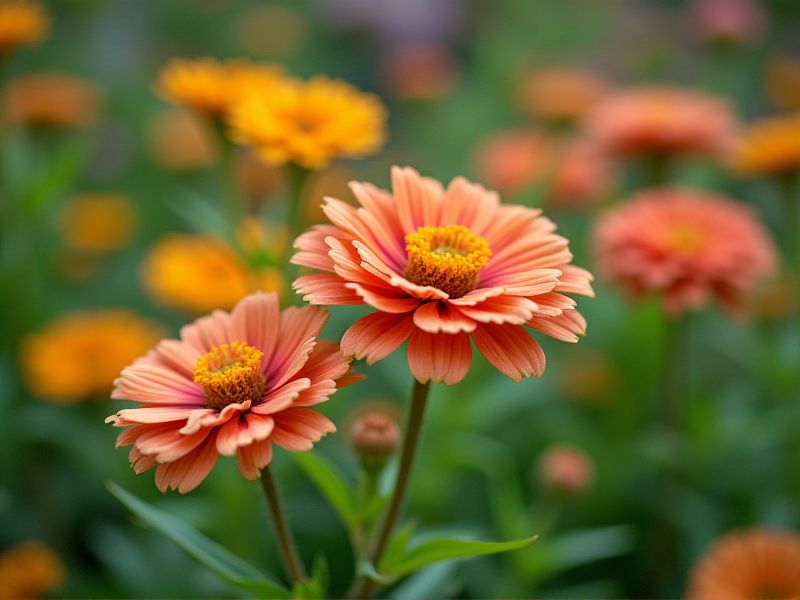
Shade-tolerant flowering plants thrive in low-light environments, making them ideal for gardens with limited sunlight. Varieties such as Astilbe, with its feathery plumes, and Hellebores, known for their early blooms, bring vibrant color to shaded areas. Hostas, while primarily known for their foliage, also produce lovely flowers that attract pollinators. Flowering ground covers like Creeping Jenny offer both blooms and lush green coverage, enhancing your garden's texture. By incorporating these plants, you can create a stunning display even in the shadiest corners of your outdoor space.
List of some Flowering plants that are shade-tolerant
- Bleeding Heart (Dicentra spectabilis)
- Hosta (Hosta spp.)
- Astilbe (Astilbe spp.)
- Lungwort (Pulmonaria spp.)
- Foxglove (Digitalis purpurea)
- Heuchera (Heuchera spp.)
- Japanese Anemone (Anemone hupehensis)
- Toad Lily (Tricyrtis hirta)
- Lenten Rose (Helleborus spp.)
- Solomon's Seal (Polygonatum spp.)
Important things about Flowering plants that are shade-tolerant
Growth Habitats
Shade-tolerant flowering plants thrive in low-light environments, making them ideal for gardens under tree canopies or shaded patios. Varieties such as Astilbe, Helleborus, and Pulmonaria not only provide vibrant blooms but also enhance the biodiversity of your garden. These plants often develop broad leaves to capture the limited sunlight, and many are native to woodland areas, showcasing adaptations to survive in such habitats. Incorporating shade-tolerant flowering plants can create an enchanting and colorful display while requiring less maintenance compared to sun-loving species.
Light Requirements
Shade-tolerant flowering plants thrive in low-light environments, making them ideal for gardens with limited sunlight. These plants, such as Astilbe, Bleeding Heart (Dicentra), and Hellebores, exhibit unique adaptations that allow them to perform photosynthesis effectively even under canopy cover. By utilizing softer, diffused light, these species can produce vibrant blooms throughout the growing season. When selecting shade-tolerant flowers, consider their specific light requirements and growth habits to enhance your shaded outdoor spaces.
Soil Preferences
Flowering plants that are shade-tolerant typically thrive in moist, well-draining soils rich in organic matter, which helps retain moisture while providing essential nutrients. Species such as Trillium and Helleborus flourish in loamy or sandy soils that maintain an adequate pH level, around 6.5 to 7.0, supporting their growth. You may also want to consider incorporating mulch or compost to improve soil structure and promote healthy root development. Choosing the right soil not only enhances flowering potential but also ensures resilience against competition from surrounding flora in low-light environments.
Watering Needs
Shade-tolerant flowering plants require a specific watering regimen to thrive in low-light environments. Regularly check the soil moisture, ensuring it remains consistently damp but not waterlogged, as excessive moisture can lead to root rot. Native species like Astilbe, Begonia, and Helleborus often showcase vibrant blooms while requiring less frequent watering compared to sun-loving varieties. Understanding your plant's unique hydration needs will enhance growth and encourage flourishing flowers even in shaded areas.
Common Varieties
Shade-tolerant flowering plants include popular varieties like hostas, astilbes, and ferns, which thrive in low-light environments. Hostas, known for their lush foliage, come in numerous cultivars and can add vibrant color to shady spots in your garden. Astilbes produce feathery plumes in shades of pink, white, and red, creating striking visual interest under trees or in shaded borders. Other options, like bleeding hearts (Dicentra spectabilis), showcase heart-shaped flowers that flourish in partial to full shade, making them ideal for enhancing the beauty of shaded areas.
Bloom Time
Shade-tolerant flowering plants, such as Astilbe and Helleborus, thrive in low-light conditions, making them ideal for gardens with dense tree canopies. These plants not only enhance the aesthetic appeal of shaded areas but also contribute to biodiversity by attracting pollinators like bees and butterflies. Their blooming periods can vary, with some varieties flowering in early spring and others peaking in late summer, allowing for a continuous display of color throughout the growing season. Incorporating shade-loving flowers into your landscape can create vibrant, lush environments that flourish even in the absence of direct sunlight.
Pest And Disease Resistance
Shade-tolerant flowering plants, such as hostas and astilbes, are often more resilient to pests and diseases due to their adapted growth conditions. These plants thrive in lower light levels, which can limit the proliferation of certain pests like aphids and spider mites, as they generally prefer sunnier environments. Incorporating integrated pest management practices, such as encouraging beneficial insects and maintaining healthy soil, can further enhance their resistance. When well-cared-for, shade-loving flowers can not only brighten dim areas but also create a vibrant ecosystem that minimizes disease impact.
Propagation Methods
Shade-tolerant flowering plants can be effectively propagated using methods such as division, layering, and seed sowing. Division is particularly beneficial for perennials like hostas and ferns, allowing you to create new plants by splitting established clumps. Layering, where stems are encouraged to root while still attached to the parent plant, is ideal for species like violets and bleeding hearts. For those interested in growing from seeds, be sure to use a soil mix that retains moisture, ensuring optimal conditions for germination in low light environments.
Companion Planting
Shade-tolerant flowering plants, like astilbe, hostas, and bleeding heart, thrive in low-light environments, making them ideal for gardens with limited sunlight. These plants not only add vibrant colors and textures to shady areas but also attract beneficial pollinators, enhancing your garden's ecosystem. Incorporating species such as ferns and lungwort alongside flowering plants can improve soil health and create a diverse habitat. For optimal results, consider pairing darker-leaved plants with lighter blooms to create a visually appealing contrast that brings life to your shaded spaces.
Seasonal Interest
Shade-tolerant flowering plants, such as Trillium and Astilbe, thrive in low-light conditions, making them perfect for shaded gardens. These plants not only provide vibrant colors but also enhance the aesthetic appeal of shaded areas throughout the growing season. Incorporating flowers like Hellebores or Bleeding Heart can bring life and texture to your shady spots while improving biodiversity in your garden. By choosing these hardy varieties, you can create a stunning floral display despite the lack of direct sunlight.
